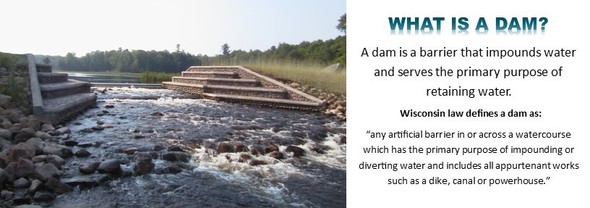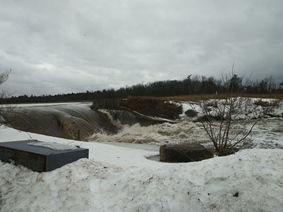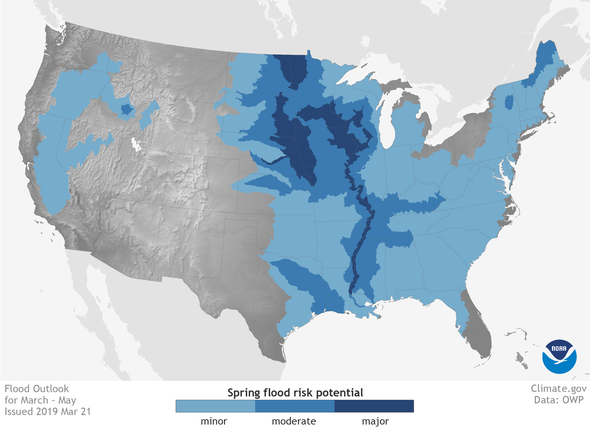|
April 2019

In mid-March, the combination of melting snow, rain and frozen ground led to significant flooding in portions of Wisconsin. Department dam safety staff received many calls during this time from dam owners who rightly activated their Emergency Action Plan (EAP). We received reports of erosion occurring because of high flows through spillways, boils (water escaping under pressure from behind or under a dam), and stuck gates, to name a few.
Thank you to those dam owners who followed the notification flowchart in their EAP and contacted the department when they observed unusual situations developing at their dams. Those dam owners showed great diligence in monitoring their dams and appropriate concern for public safety in the downstream area. Dam safety staff were notified of the EAP activations and provided technical support and assistance with emergency response communications. This is how the EAP notification process is intended to work!
The National Oceanic and Atmospheric Administration (NOAA) recently released a spring flood and climate outlook, stating, “A wet winter has primed much of the Great Plains for spring flooding in 2019.” In addition, this spring Wisconsin has an elevated risk for well-above average precipitation.
If the March 2019 flooding event happened at your dam or if more spring or summer flooding occurs, would your EAP be ready?
For more information, see our EAP page.
The Dam Safety Program is offering information sessions around the state for dam owners to learn about drafting and updating Emergency Action Plans (EAPs) and understanding Dam Failure Analyses (DFAs). Wisconsin requires EAPs and DFAs for large dams and attendees of last summer’s information sessions requested instruction on these documents. Water management engineers from the Dam Safety Program will staff each informational session to explain these important documents and to answer questions. We hope to see you there!
Wednesday, April 24 in Richland Center
457 Melvill Hall Pippin Center at UW-Richland
1200 US-14, Richland Center, WI 53581
Thursday, April 25 in Waukesha County
Town of Concord County Community Center
W1095 Concord Center Drive, Sullivan, WI 53178
Wednesday, May 1 in Eau Claire
Business Education Center (BEC 30A)
Chippewa Valley Technical College
620 West Clairemont Avenue, Eau Claire, WI 54701
Thursday, May 2 in Tomahawk
Rodeway Inn & Suites
1738 Comfort Drive, Tomahawk, WI 54487
All sessions are from 9 am to 12pm. No RSVP required. Snacks provided, but no lunch or beverages will be available.
Dam owners have a responsibility to maintain their dams in a safe condition. Liability can be imposed upon dam owners for failure to maintain, repair or operate their dams in a safe and proper manner. One very important component of dam safety is owner education, and there are many resources available!
The Wisconsin DNR dam safety webpage has information about many topics including: inspection preparations, hiring a consultant, state regulations, and permit applications.
More free resources are available for dam owners and operators at DamOwner.org. In Twitter, search on #DamSafety or #DamOwner for more information. The Association of State Dam Safety Officials (ASDSO) developed this site with dam owners in mind. This tool makes it easy for owners to access information and understand what steps are needed to minimize risk at their dam. DamOwner.org is a continuous work in progress and new features will be added over time.
ASDSO is a national non-profit organization serving state dam safety programs and the broader dam safety community with the vision of “a future where all dams are safe.”

Winter snows are melting, and the days are getting longer. All the signs are here indicating another winter is behind us and spring has finally arrived. What does this seasonal transition mean to you as the owner and operator of a dam?
Spring clean-up is essential to maintain your dam in good working condition and to identify any changes that may have occurred over the winter months. Early spring is also a great time to walk the embankment of your dam to see how the earthen portion of your structure is performing.
As ice in the impoundment behind your dam breaks up and melts, ice jams may begin to form which could obstruct flow and raise the water level in the impoundment. Spring rains coupled with snow melt may also cause impoundment water levels to increase and subsequently cause increased flow through the spillway.
With this potential for increased flow, any organic debris that may have built up during the winter months needs to be removed from the spillway inlet. For these higher flows to pass safely, check the spillway of your dam regularly, this time of year, and remove accumulated debris. If your dam has an auxiliary spillway, check and clear it to ensure that it can pass higher flows if impoundment water levels exceed the capacity of the primary spillway.
Snow melt presents a good time to inspect the earthen embankments for changes that may have occurred over the winter months. Dormant vegetation on the embankments allows for inspection of the upstream and downstream slopes of the dam and identification of areas of instability or changes, such as scarps or sloughing of soils. If you discover slope instabilities, contact your consultant or the department regional dam safety engineer. It is easier to see new and old rodent burrows prior to the green-up of the embankment vegetation. You should clean out these features and fill the resulting holes with clean, firmly compacted fill soil.
It is important to use proper safety equipment when working around the spillway of your dam. Typically, in early spring, areas of the ground are still frozen and slippery. For safety, it is wise to have additional assistance when performing any work or debris removal around the spillway. Lastly, higher flows during this season may require the implementation of your Emergency Action Plan. Make sure the data contained in this document is accurate and up to date.
|


Please welcome Tanya Lourigan in the position of state dam safety engineer. Tanya recently started in this position, which has been vacant since Bill Sturtevant retired in 2018.The state dam safety engineer provides statewide oversight of policy and regulation, technical standards, emergency response, inspection, and enforcement activities related to design, construction and safety of dams.
Tanya is originally from Madison, Wisconsin, and graduated with a B.S. in civil engineering from UW-Madison. During school, she worked part-time for DNR Facilities and Lands assisting with surveys. Following school, she worked for several years with the U.S. Forest Service (Tongass National Forest, Sitka, Alaska) in their Facilities/Engineering Division. Then Tanya moved “down south” to New York State where she worked for a non-profit in the foothills of the Catskills.
Tanya returned to Madison in 2003 and earned an M.S. in urban and regional planning, with an emphasis on water resources, from UW-Madison. While in school, she worked part-time for the River Alliance of Wisconsin collecting data for a study examining the impact of small dam removals on property values.
Things have come full circle for Tanya. Her career started as a student at UW-Madison, then took her from one end of the United States to another and then back to Wisconsin. She has been working at the DNR for the last 12 years as a water management engineer in the Dam Safety and Floodplain Program, with seven of those years in the Southeast Region and five in Southcentral. She is excited to continue furthering the Dam Safety Program goals!
Now that Tanya is the state dam safety engineer, please see our water management engineer coverage page to determine who is covering her previous counties.
|
|